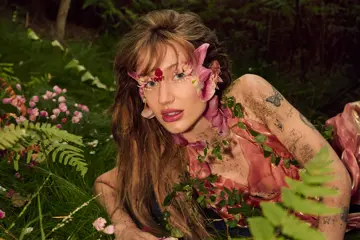 Tyondai Braxton
Tyondai BraxtonThink of electronic music, then hurl those ideas into the stratosphere. Mix with time, space and mind-blowing visuals and you might come close to this musical highlight of the Sydney Festival, a sensory overload.
100 Million Nights is a collaboration between artist Daniel Boyd and Perth-born electronic duo Canyons, aka Ryan Grieve and Leo Thomson. Canyons had two extra pairs of hands on deck to bring to life their sonic interpretations of Boyd's psychedelic-historic film reels, projected onto a huge three-panel screen and filtered through thousands of dots recalling Aboriginal art.
As splashes of colour first filled the screen, the opening to Boyd's reimagining of Indigenous and European-Australian history, a funky, pulsing beat moved with it, before the scene was replaced entirely by white, all sound suspended in an eerie purgatory.
The performance was marked by dramatic changes of pace, imbuing the suite of songs with deep meaning for those looking for it. More simplistically, it was an intense romp of colour, psychedelic patterns and beats that at times would be equally at home on the dancefloor as in the Concert Hall. Canyons are known for playing most of the instruments on their records and it was great to see Grieve jump between guitar, drums and exotic percussion while Thomson owned the electronics with precision and rhythm.
Don't miss a beat with our FREE daily newsletter
This apparently was just a taste of the intensity to come from Tyondai Braxton. The former Battles frontman now makes his name as a brilliant electronic composer. He and four other musicians each appeared from the gloom, seated cross-legged, atop custom-built platforms that resembled warmly lit mushrooms. Given what followed, you'd be forgiven for thinking you'd accidentally ingested some magic ones.
Squelchy synths from Braxton and his companion on one side, both with laptops open, meshed with intricate rhythms from the three on the other, each surrounded by assorted percussion and sheet music. It was truly a mix of digital and natural as piercing birdcall samples complemented incredibly tight drumming. At one point, all rapidly tapping blocks in sync, the three percussionists were the sonic equivalent of a giant, persistent cicada.
It's shows like this that remind you that music is the best kind of art – the kind that leaves your ears ringing and still wanting more.















